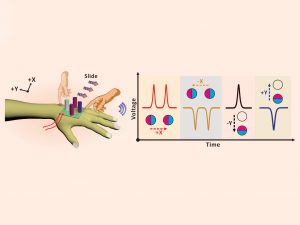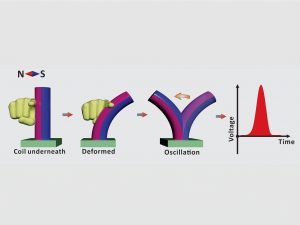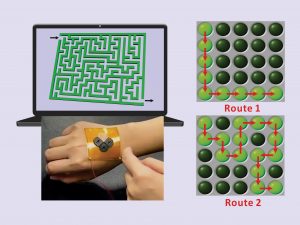Electronic skin (E-skin) is a novel, lightweight, and flexible wearable device that mimics the sensory function of human skin. By collecting mechanical stimuli and converting them into electrical readouts, E-skin acts as an important link connecting human and electronic terminals. It has attracted increased attention due to its potential applications in various fields, ranging from healthcare monitoring to intelligent perceptions. Therefore, our research group has developed a lightweight, self-powered, and wearable patch by incorporating the principles of ‘electromagnetic induction’ and ‘intrinsic oscillation of elastomer’. This innovative patch offers a fresh perspective on designing future wearable human-machine interaction (HMI) interfaces in a more concise and convenient approach.
A Law of Classical Physics: Electromagnetic Induction
Faraday’s law of electromagnetic induction is a fundamental law in physics that serves as the basic operating principle of various inductors and generators. According to this law, a change in magnetic flux can induce an electromotive force (EMF) when a conductive coil layer is present. This classical law inspired us to explore the conversion of mechanical energy into electrical energy by altering the spatial distribution of magnetic flux. By leveraging this principle, flexible E-skin can operate in a self-powered manner, reducing reliance on external power consumption, provided that it is comprised of flexible magnetised components and conductors.
Nature-Inspired Intrinsic Oscillation of Elastic Microstructures
According to Faraday’s law, the time scale also plays a role in determining the magnitude of the EMF. A more significant EMF signal can be obtained if the magnetic flux variation is completed within a shorter duration. This is essential to improving accuracy and avoiding noise interference in real-world applications.
Inspired by natural phenomena, many elastic systems exhibit eigenfrequency, which is primarily determined by the properties of their structure. For example, the frequency of a block-spring system is determined by the spring constant and block mass, while the period of a simple pendulum depends on the length of the string.
Our research group found that artificial elastic micro-structures (micropillars) also follow rules similar to those of natural behaviour. The micropillars are mainly composed of elastomer gel and microparticles (NdFeB) that can produce a permanent magnetic moment after magnetisation. In subsequent studies, we demonstrated that the eigenfrequency of the elastic micropillars can be tuned by simply adjusting their dimensional parameters or physical properties. These findings enable us to significantly shorten the oscillation period of the magnetised elastic micropillars, thereby generating more pronounced electrical signals and ensuring accurate communication.
Magnetic Dipole for Direction-Aware Sensing
In nature, magnets have two poles, the north pole and the south pole, which form a magnetic dipole. If you break a permanent magnet, the two daughter magnets will each have a north pole and a south pole. The same rule applies to even smaller magnets such as the micron-sized micropillars, which, once magnetised, also have a pair of north and south poles.
Based on this observation, our research group believes that the magnet’s north and south poles could serve as a mechanism to perceive the force direction. When a magnetised micropillar is deformed towards the north or south side, a negative or positive variation of the magnetic flux in the conductive coil will be generated. These ultimately become EMF signals of ‘+/-’ or ‘-/+’ that can be clearly distinguished and accurately identified by the electrical terminal.
Designing a Wearable Patch for In-Plane Force Perception
A single magnetised micropillar can only respond to two opposite directions of force in one dimension based on the positive and negative signals of the induced EMF. To address this limitation, our research group discovered that the number of voltage peaks can identify the in-plane force from different axial directions (+X, -X, +Y, and -Y).
We developed an interface for measuring directional in-plane force by precisely designing the orientation and arrangement of magnetised micropillars. Based on the number and polarity of voltage peaks, the interface can perceive the in-plane forces in the +X, -X, +Y, and -Y directions with non-overlapping readouts. As a result, the wearable interface requires only one communication channel and two electrodes to distinguish mechanical input from four different directions.
Wearable Patch: From Intelligent Control to Entertainment
A wearable HMI system should be lightweight and low-power in order to be user-friendly, and our design satisfies these requirements. Additionally, the electric connection and communication method are important considerations in assessing the practicability of HMI systems. While some researchers use wearable sensor arrays as the HMI interface, this approach inevitably brings concerns about power consumption and space occupied due to the multiple electric connections and communication channels involved. In contrast, as our design can produce non-overlapping signals according to different force directions, only one communication channel is required to complete the signal interaction process.
To evaluate the multiple functions of the wearable patch, we developed the application interfaces for trajectory mapping, robot control, digital password input, and Morse code communication, among others. Throughout the application process, the wearable patch demonstrated robustness, humidity resistance, accuracy, and universal applicability. We expect that this wearable patch can provide a new solution to meet the ever-growing demand for effective HMI in flexible and wearable electronics. The related research results were recently published in the Chemical Engineering Journal.
Authors:
Fang Dan is a PhD candidate in the Institute of Applied Physics and Materials Engineering at the University of Macau. She is the first author of the related publication. Her research interests include flexible sensors and smart materials.
Zhou Bingpu is an associate professor in the Institute of Applied Physics and Materials Engineering at the University of Macau. He holds a PhD in Nano Science and Technology from the Hong Kong University of Science and Technology. His research interests include flexible electronics, wearable devices, and smart interfaces.
Text & Photo / Fang Dan & Zhou Bingpu
Chinese Translation / Davis Ip
Source: UMagazine ISSUE 28

The design of the wearable interface consists of four micropillars and one coil substrate for force direction perception. Different axial forces can induce identifiable patterns of

Signals are generated via deforming a magnetised micropillar to induce magnetic flux change in the conductive coil layer

Demonstration of maze game using an on-skin wearable interface: two routes can be easily produced by sweeping the micropillar assembly in different directions

Fang Dan

Zhou Bingpu
